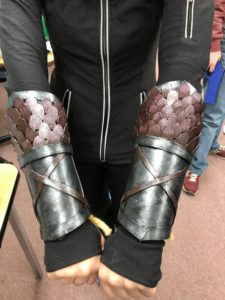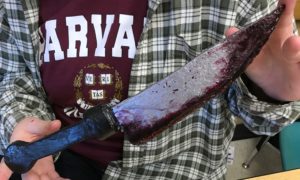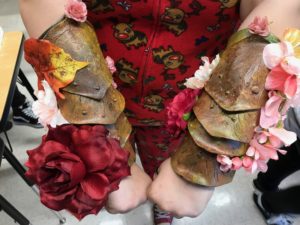
Okay. Its time for some serious teacher speak. I genuinely try to avoid pulling out my metaphorical teacher guns, but sometimes ya’ gotta’ flex those academical muscles to back up the things you do in a classroom.
So, why teach cosplay?
The answer is surprisingly simple: STEAM.
Not the type you get when boiling water. In teacher lingo, STEAM stands for Science, Technology, Engineering, Art and Mathematical practices. STEAM is widely considered the Bermuda Triangle of education – hard to find and some crazy cool stuff happens inside it’s borders.
Cosplay provides students genuine opportunities to experience STEAM.
Consider the last thing you made – it doesn’t even have to be about cosplay. Whatever crafty project you were working on, it probably required a plethora of skills working side-by-side:
-

“Can I modify the pattern to make something a little different?” This student did a great job adapting the tutorial to make it their own. You were undoubtedly asking questions and seeking answers (science!).
- I bet you conducted research using digital resources (technology!).
- Didn’t you have to figure some stuff out…trial and error, making patterns, prototypes, etc (engineering!)?
- There was definitely some measurements and numbers reasoning happening (math!).
- And to top it all off, I’m sure you left your own personal mark on that project (art!).
For students, cosplay offers authentic, interesting projects that challenge them to think creatively and strategically. By working on multiple projects, they revisit and reflect on their practices, a genuine opportunity for metacognition that rarely appears in other classes (this makes me so frustrated, because I also teach science!).
The typical cosplay project goes like this:
- student selects a tutorial they are interested in,
- student does some Google image searches or looks at their Pinterest board to collect/compare ideas.
- student tweaks and existing design or designs something novel.
- student begins the process of actually creating this project: they ask questions, observe what others are doing, reason through the process, make creative decisions, learn how to work with different materials, exercise patience when things don’t go their way….etc. etc. etc.
- student finishes project, excited to try something new or do something different to get a better result.

Throughout every step of the cosplay class, students are practicing thinking and reasoning skills. They are asking questions and seeking answers. And the reality is, they are excited to do it! Cosplay is fun because kids get to express their fandom in creative ways. In teacher speak, that means students are invested in the process and eager to learn more WHILE exercising technical skill sets.
Can you imagine not tricking or enticing your students to engage in instruction? I couldn’t either until I started to teach cosplay.
There’s also some official standards that cosplay aligns with. Here are some of the NGSS standards that happen in cosplay:
MS-ETS1-2: Evaluate competing design solutions using a systematic process to determine how well they meet the criteria and constraints of the problem.
HS-ETS1-2: Design a solution to a complex. real-world problem by breaking it down into smaller, more manageable problems that can be solved through engineering.

All-in-all, cosplay is pretty amazeballs. And the bottom line is this: cosplay engages students in challenging, thought-provoking exercises that begin low-floor and end high-ceiling. Every kid can access cosplay, which means every kid experiences genuine engineering practices in the context of making art pieces inspired by their favorite fandoms.
I told you, amazeballs!